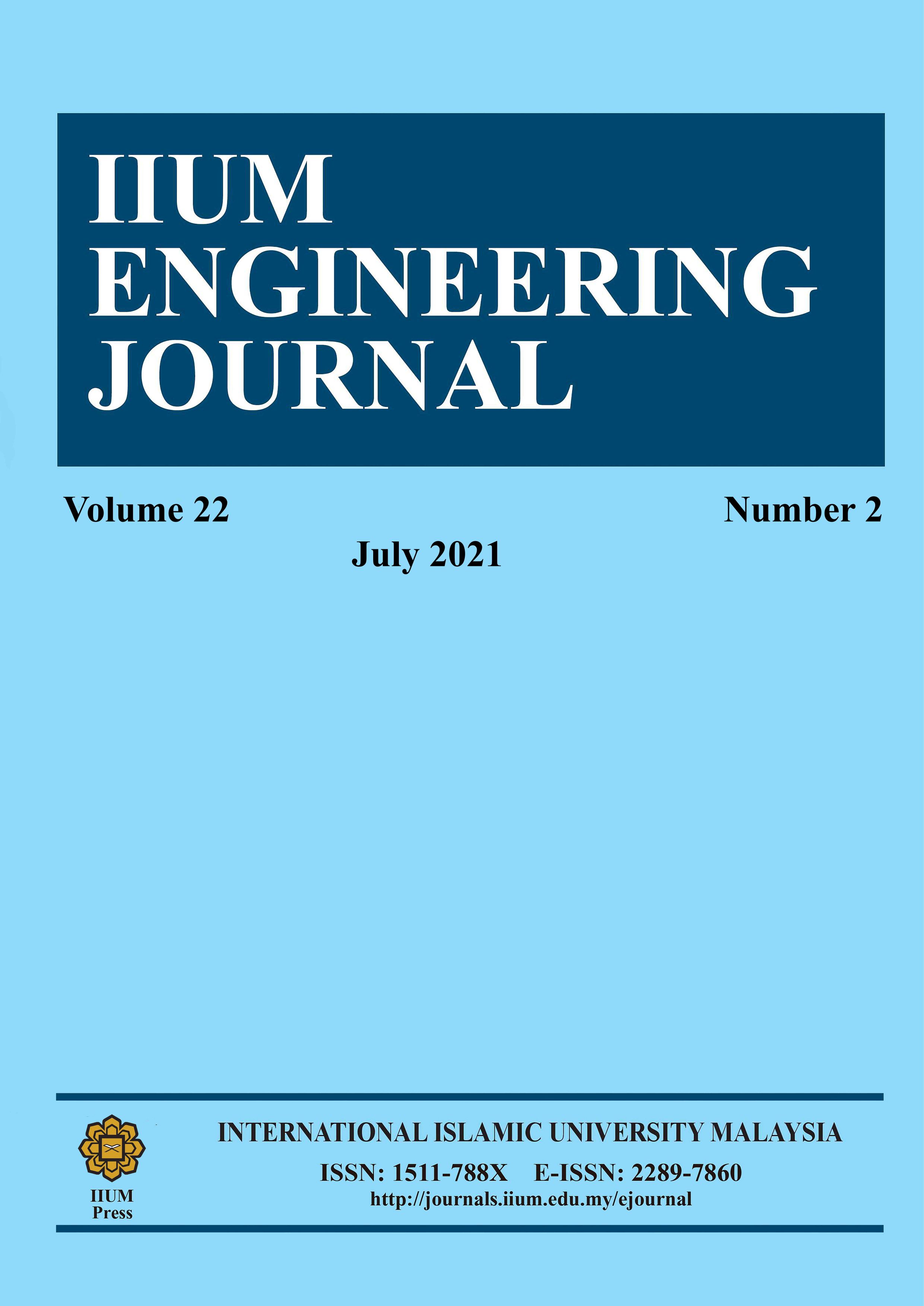INFLUENCE OF DIFFERENT PERCENTAGE BOILER ASH-BASED GEOPOLYMER IN LATERITE SOIL
DOI:
https://doi.org/10.31436/iiumej.v22i2.1589Keywords:
laterite soil, palm oil boiler ash, geopolymer, compressive strengthAbstract
The waste generation of palm oil boiler ash has been one of its big problems as it is less used and deposited in landfills as a by-product. Geopolymer is a new green technology that has been intensively studied in concrete applications. However, few studies on geopolymers have been conducted in soil applications. Thus, this study investigated the influence of palm oil boiler ash-based geopolymer in laterite soil strength. Different percentages, 5, 10, 15, and 20% of geopolymer mixtures, were added to laterite soil. The process of producing a geopolymer binder was performed by sieving boiler ash (150 µm), then mixing with sodium hydroxide (NaOH) and sodium silicate (Na2SiO3) as an alkaline activator at a ratio of 1:2. This material effectiveness was tested through compaction test using a standard proctor, unconfined compressive strength, and the scanning electron microscope (SEM). 15% of geopolymer in laterite soil indicated the best-mixed design with a maximum dry density of 2.23 Mg/m3 with a moisture content of 13.58%. The unconfined compressive strength test at curing times of zero, seven, and twenty-eight days on the LS-15.0 GPOBA sample, show a slightly increased strength of 47, 58, and 76 kPa, respectively. The SEM images proved that the geopolymer gel's development stabilized the soil structure from a loose structure to a denser soil structure. This study aims to investigate the influence of geopolymer in laterite soil. Boiler ash as an alternative material in geotechnical applications was studied to understand and develop new green alternative materials to sustain the environment from industrial waste and to enhance laterite soil properties.
ABSTRAK: Abu kelapa sawit adalah salah satu sisa utama yang terhasil dari industri kelapa sawit tetapi penggunaannya kurang dimanfaatkan dan dibuang ke tempat pembuangan sampah. Teknologi hijau baru yang dikenali sebagai geopolimer telah dikaji secara intensif dengan kekuatan konkrit tetapi hanya sedikit kajian telah dibuat dalam penggunaan tanah. Tujuan kajian ini adalah bagi mengesan geopolimer berasaskan abu kelapa sawit terhadap kekuatan tanah laterit. Peratusan campuran geopolimer yang berbeza (0, 5, 10, 15 dan 20%) dicampur pada tanah laterit. Bagi menghasilkan geopolimer, saiz 150 ?m abu kelapa sawit disintesis dengan kombinasi bahan kimia natrium hidroksida (NaOH) dan natrium silikat (Na2SiO3) pada nisbah 1:2 bagi semua campuran sebagai pengaktif alkali. Ujian terhadap keberkesanan bahan adalah melalui proses ujian pemampatan menggunakan proktor standard, kekuatan pemampatan tidak terbatas, dan Pengimbas Mikroskop Elektron (SEM). Berdasarkan dapatan ujian pemadatan, 15% geopolimer di tanah laterit menunjukkan campuran terbaik dengan memberikan kepadatan pengeringan maksimum 2.23 Mg/m3 pada kelembapan 13.58%. Ujian kekuatan mampatan tidak terbatas pada masa pempolimeran sebanyak 0, 7 dan 28 hari diuji pada sampel LS-15.0GPOBA bagi menguji kekuatan campuran. Dapatan menunjukkan kekuatan geopolimer sedikit meningkat pada 47, 58 dan 76, masing-masing. Imej SEM membuktikan pengembangan gel geopolimer menstabilkan struktur tanah daripada struktur lopong kepada struktur tanah padat. Oleh itu, abu kelapa sawit berasaskan geopolimer dan tanah laterit berpotensi sebagai alternatif bagi merawat tanah dalam aplikasi geoteknik dan berpotensi mengurangkan kadar kebolehtelapan.
Downloads
Metrics
References
Hai TC, Ng A, Prudente C, Pang C, Tek Choon Yess, J. (2001) Balancing the Need for Sustainable Oil Palm Development and Conservation: The Lower Kinabatangan Floodplains Experience. Strategic Directions for The Sustainability of the Oil Palm Industry, 53 pp. Retrieved From http://Assets.Panda.Org/Downloads/Balancingtheneed.pdf
Abdullah N, Sulaim F. (2013) The Oil Palm Wastes in Malaysia. in Biomass Now - Sustainable Growth and Use. Intech. https://doi.Org/10.5772/55302 DOI: https://doi.org/10.5772/55302
Mangi,SA, Ibrahim MHW, Jamaluddin N, Arshad MF, Memon, FA, Jaya RP, Shahidan S. (2018) A Review on Potential Use of Coal Bottom Ash as a Supplementary Cementing Material in Sustainable Concrete Construction. International Journal of Integrated Engineering, 10(9): 127-135. https://doi.Org/10.30880/Ijie.2018.10.09.006 DOI: https://doi.org/10.30880/ijie.2018.10.09.006
Deraman LM, Al Bakri Abdullah,MM, Ming LY, Hussin K, Yahya Z. (2015) A Review on Processing and Properties of Bottom Ash Based Geopolymer Materials. in Key Engineering Materials, 660: 3-8. https://doi.Org/10.4028/www.Scientific.Net/KEM.660.3 DOI: https://doi.org/10.4028/www.scientific.net/KEM.660.3
Davidovits J. (2005) Geopolymer, Green Chemistry and Sustainable Development Solutions. in J. Davidovits (Ed.), Proceedings of the World Congress Geopolymer 2005 (p. 236). Institut Geopolymere.
Wattimena OK, Antoni, Hardjito D. (2017) A review on the effect of fly ash characteristics and their variations on the synthesis of fly ash based geopolymer. in AIP Conference Proceedings, 1887: 020041. https://doi.org/10.1063/1.5003524 DOI: https://doi.org/10.1063/1.5003524
H Xu, Van Deventer JSJ. (2000) The geopolymerisation of alumina-silicate minerals. Int. J. Miner. Process., 59(3): 247-266. DOI: https://doi.org/10.1016/S0301-7516(99)00074-5
Van Jaarsveld JGS, Van Deventer JSJ, Lorenzen L. (1997) Potential use of geopolymeric materials to immobilize toxic metals: Part I. Theory and applications, Miner. Eng., 10(7): 659-669. DOI: https://doi.org/10.1016/S0892-6875(97)00046-0
Kanesan D, Ridha S, Rao P. (2017) Formulation of geopolymer cement using mixture of slag and class f fly ash for oil well cementing. In IOP Conference Series: Materials Science and Engineering, 201: 012014. https://doi.org/10.1088/1757-899x/201/1/012014 DOI: https://doi.org/10.1088/1757-899X/201/1/012014
Nanavati S, Chetan Nanavati S, Jaywant Lulla S, Ranjeet Singh A, Bharat Mehta D, Mohan Patel A, Author C. (2017) A review on fly ash based geopolymer concrete. IOSR Journal of Mechanical and Civil Engineering, 14(4): 12-16. https://doi.org/10.9790/1684-1404071216
Kabir SMA, Alengaram UJ, Jumaat MZ, Sharmin A, Islam A. (2015) Influence of molarity and chemical composition on the development of compressive strength in POFA based geopolymer mortar. Advances in Materials Science and Engineering, 2015: 647071 https://doi.org/10.1155/2015/647071. DOI: https://doi.org/10.1155/2015/647071
Yahya Z, Abdullah MMAB, Hussin K, Ismail KN, Razak RA, Sandu AV. (2015) Effect of solids-to-liquids, Na2SiO3-to-NaOH and curing temperature on the palm oil boiler ash (Si + Ca) geopolymerisation system. Materials, 8(5): 2227-2242. https://doi.org/10.3390/ma8052227. DOI: https://doi.org/10.3390/ma8052227
Lopez E., Vega-Zamanillo A., Calzada Perez M.A., & Hernandez-Sanz A. (2015). Bearing capacity of bottom ash and its mixture with soils. Soils and Foundations, 55, 529–535. https://doi.org/10.1016/j.sandf.2015.04.005 DOI: https://doi.org/10.1016/j.sandf.2015.04.005
Jindal B. B. (2019). Investigations on the properties of geopolymer mortar and concrete with mineral admixtures: A review. Construction and Building Materials. Elsevier Ltd. https://doi.org/10.1016/j.conbuildmat.2019.08.025. DOI: https://doi.org/10.1016/j.conbuildmat.2019.08.025
Ma C. K, Awan, A. Z., & Omar W. (2018). Structural and material performance of geopolymer concrete: A review. Construction and Building Materials. Elsevier Ltd. https://doi.org/10.1016/j.conbuildmat.2018.07.111. DOI: https://doi.org/10.1016/j.conbuildmat.2018.07.111
Duchesne J., Duong L., Bostrom T., & Frost R. (2010). Microstructure study of early in situ reaction of fly ash geopolymer observed by environmental scanning electron microscopy (ESEM). Waste and Biomass Valorization, 1(3), 367–377. https://doi.org/10.1007/s12649-010-9036-4. DOI: https://doi.org/10.1007/s12649-010-9036-4
Khan, H., Purohit, D., Bagara, D., & Pahadiya, H.S. (2016). Geopolymer Concrete with Replacement of Cement. International Journal of Engineering Research & Technology (IJERT) 4-23.
Emdadi, Z., Asim, N., Amin, M. H., Yarmo, M. A., Maleki, A., Azizi, M., & Sopian, K. (2017). Development of Green Geopolymer Using Agricultural and Industrial waste Materials with High Water Absorbency. Applied Sciences (Switzerland), 7(5). https://doi.org/10.3390/app7050514. DOI: https://doi.org/10.3390/app7050514
Puertas, F. & Mart?inez-Ram?irez, S & Alonso, S & Vazquez, T. (2000). Alkali-Activated Fly Ash/Slag Cement Strength Behavior and Hydration Products. Cement and Concrete Research. 301. 1625-1632. DOI: https://doi.org/10.1016/S0008-8846(00)00298-2
Skvara, F., Kopecky, L., Nemecek, J., & Bittnar, Z. (2006). Microstructure of geopolymer materials based on fly ash. Ceramics - Silikaty, 50(4), 208–215.
Rosli, Ros, Nadiah. (2017). Properties of Laterite Soils from Sources Near Nibong Tebal, Malaysia. Conference: ICONTES Vistana Hotel Kuala Lumpur https://www.researchgate.net/publication/324720622
Sujeeth, Ahmed. (2015). An Investigation into The Geotechnical Engineering Properties of Laterite Soils in Nilai, Malaysia. 10.13140/RG.2.2.20036.04489.
Marto, A., Latifi, N., & Sohaei, H. (2013). Stabilization of laterite soil using GKS soil stabilizer. Electronic Journal of Geotechnical Engineering, 18 C, 521–532.
Parikshith, M. V., & Sekhar, D. C. (2019). Feasibility of fly-ash based geopolymer for soil stabilization. International Journal of Innovative Technology and Exploring Engineering, 9(1), 4348–4351. https://doi.org/10.35940/ijitee.A5019.119119 DOI: https://doi.org/10.35940/ijitee.A5019.119119
Mukri, M., Aziz, N. N. S., & Khalid, N. (2018). Geopolymer Effect in Modelling Hydraulic Conductivity for Designing Soil Liner of Laterite Soil. International Journal of Civil Engineering and Technology, 9(7), 1962–1974.
Liu, Z., Cai, C. S., Liu, F., & Fan, F. (2016). Feasibility study of loess stabilization with fly ash-based geopolymer. Journal of Materials in Civil Engineering, 28(5). https://doi.org/10.1061/(ASCE)MT.1943-5533.0001490. DOI: https://doi.org/10.1061/(ASCE)MT.1943-5533.0001490
Nikolic, I., Zejak, R., Radmilovic, V., Blecic, D., & Tadic, M. (2012). Geopolymerization of fly ash as a possible solution for stabilization of used sandblasting grit.
Thiha, S., Lertsuriyakul, C., & Phueakphum, D. (2018). Shear Strength Enhancement of Compacted Soils Using High-Calcium Fly Ash-Based Geopolymer. International Journal of GEOMATE, 15(48), 1–9. https://doi.org/10.21660/2018.48.35692 DOI: https://doi.org/10.21660/2018.48.35692
Dheyab, W., Ismael, Z. T., Hussein, M. A., & Huat, B. B. K. (2019). Soil stabilization with geopolymers for low cost and environmentally friendly construction. International Journal of GEOMATE, 17(63), 271–280. https://doi.org/10.21660/2019.63.8159 DOI: https://doi.org/10.21660/2019.63.8159
Nik Ab Aziz, N. N. S., Mukri, M., Hashim, S., & Khalid, N. (2015). Influence of Compaction Effort for Laterite Soil Mix with Geopolymer In Designing Soil Liner. Electronic Journal of Geotechnical Engineering, 20(22), 12353–12364.
Ahmad, F. H., Mukri, M., & Azmi, N. A. C. (2017). Effectiveness of Different Percentage of Bentonite in Soil Liner on Interface Shear Strength with Geosynthetic. International Journal of Applied Engineering Research, 12(7), 1360–1364.
Ashraf, M. A., Hossen, M. A., Ali, M. A., & Chakaraborty, B. P. (2018). Stabilization of Soil by Mixing with Different Percentages of Lime, 1–10. The 4th International Conference on Civil Engineering for Sustainable Development
Zhou, S. Q., Zhou, D. W., Zhang, Y. F., & Wang, W. J. (2019). Study on Physical-Mechanical Properties and Microstructure of Expansive Soil Stabilized with Fly Ash and Lime. Advances in Civil Engineering. https://doi.org/10.1155/2019/4693757 DOI: https://doi.org/10.1155/2019/4693757
Fattah, M., Y., Al-Saidi, A., And Jaber, M. (2014) Consolidation Properties of Compacted Soft Soil Stabilized with Lime-Silica Fume Mix. International Journal of Scientific & Engineering Research, 5, 1675-1682.
Noushini, A., & Castel, A. (2016). The Effect of Heat-Curing on Transport Properties of Low-Calcium Fly Ash-Based Geopolymer Concrete. Construction and Building Materials, 112, 464–477. https://doi.org/10.1016/j.conbuildmat.2016.02.210. DOI: https://doi.org/10.1016/j.conbuildmat.2016.02.210
Nawaz, M. F., Bourrié, G., & Trolard, F. (2013). Soil Compaction Impact and Modelling. A Review. Agronomy for Sustainable Development, 33(2), 291–309. https://doi.org/10.1007/s13593-011-0071-8. DOI: https://doi.org/10.1007/s13593-011-0071-8
Khale, D., & Chaudhary, R. (2007). Mechanism of Geopolymerization and Factors Influencing Its Development: A Review. Journal of Materials Science, 42(3), 729–746. https://doi.org/10.1007/s10853-006-0401-4. DOI: https://doi.org/10.1007/s10853-006-0401-4
Alvarez-Ayuso, E., Querol, X., Plana, F., Alastuey, A., Moreno, N., Izquierdo, M., Barra, M. (2008). Environmental, Physical and Structural Characterization of Geopolymer Matrixes Synthesized from Coal (Co-)Combustion Fly Ashes. Journal of Hazardous Materials, 154(1–3), 175–183. https://doi.org/10.1016/j.jhazmat.2007.10.008 DOI: https://doi.org/10.1016/j.jhazmat.2007.10.008
Temuujin, J., & Van Riessen, A. (2009). Effect of Fly Ash Preliminary Calcination on The Properties of Geopolymer. Journal of Hazardous Materials, 164(2–3), 634–639. https://doi.org/10.1016/j.jhazmat.2008.08.065. DOI: https://doi.org/10.1016/j.jhazmat.2008.08.065
Downloads
Published
How to Cite
Issue
Section
License
Copyright (c) 2021 IIUM Press

This work is licensed under a Creative Commons Attribution-NonCommercial 4.0 International License.






















